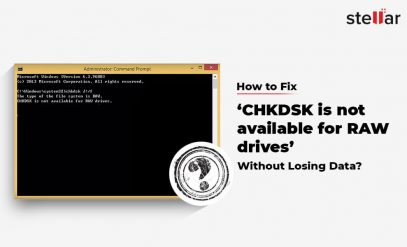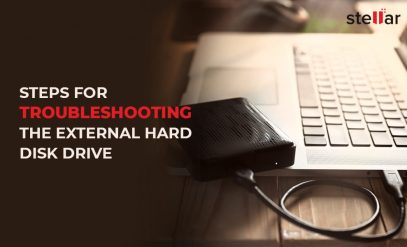A bad hard drive might be a reason for multiple problems on the computer system. In order to resolve these issues, you need to check the condition of the hard drive. There are various methods available to predict the hard disk drive (HDD) failure that informs us about the exact reason behind it. Usually, hard drive grinding and thrashing noises are reliable indicators to predict the HDD failure, but what if you are handling the drive remotely and cannot analyse the drive concretely or the drive does not show any signs of failure at all.
Here are some possible issues that you might encounter due to a bad disk drive:
- The computer is showing errors while reading, copying, moving, or deleting data.
- The computer shows random errors or reboots automatically.
- Slow system.
- The operating system is not able to boot.
Although, there are software programs available that are specifically designed to check your hard drive errors. But using these technologies often misleads users from exact issues of the hard drive and provides the wrong estimation of the time for failure. Therefore, most of the users follow a more sophisticated method in order to predict HDD failure, named as (Self-Monitoring, Analysis and Reporting Technology) S.M.A.R.T that detects and reports all the indicators of drive reliability, and shows the possibilities of hardware failures.
Its metrics track the hard drive and provides complete performance information including the number of hours the drive has been switched on, slow spin time to reach operational speed and the count of reallocated sectors, high temperature, and excessive bad sector etc. to the operating system. You can view and analyse this data through software to check the health of the connected storage equipment. Windows user can get the S.M.A.R.T reading through command prompt as well.
Whenever the S.M.A.R.T. data anticipates a possibility of hard drive failure, the software running on the host system may notify the user, so that the users can copy their important data to prevent data loss, and replace the failing drive. If the hard drive is generating S.M.A.R.T errors, then it is always suggested to replace it.
Analyse S.M.A.R.T data and what you should do next
- Checking S.M.A.R.T. error in your system is generally quite simple, it is basically a prediction that the drive failure is going to occur. Whenever the system’s threshold exceeds, it gets the S.M.A.R.T. error and generates a report. A system S.M.A.R.T. error is an indication that user should start backing up the data regularly to keep it safe.
- Some of the S.M.A.R.T. warnings can be handled easily such as excessive average temperature and can be fixed by refining ventilation. Therefore, after getting an error first you should check out the possible solution of the error so that the S.M.A.R.T. error may disappear. However, if there is no possible way available to repair the underlying problem, then the user should consider a replacement.
- Some latest models of hard drive like Solid State Drives (SSDs) include additional S.M.A.R.T. fields that some manufacturers’ BIOS’s don’t interpret correctly. To resolve such issue you can go to the manufacturer’s website and check for an update for the computer’s BIOS. In case no updates are available or even the update does not involve S.M.A.R.T. errors, then you should consult to your motherboard’s manufacturer to get the instructions to disable S.M.A.R.T. tests from the BIOS.
The accuracy of the S.M.A.R.T tool
In the above section, you might have understood that the S.M.A.R.T tool is an indicator of a hard drive health. But do you know how reliable these results are? Here you will get to know about the reliability factor of the S.M.A.R.T tool.
- A S.M.A.R.T tool is not capable of predicting 100% of hard drive crashes, because all the hard drive crash predictions are not correct initially, as these errors could rise due to regular mechanical issues might analyse abnormally by the S.M.A.R.T readings. However, at times, some of the system issues like sudden electronic malfunctions and component failures do not show S.M.A.R.T errors. After analysing all of such cases, a 2007 Google study covered almost 100,000 consumer-grade HDDs found that 64% of hard drive failures were not detected by their S.M.A.R.T tools, over a nine-month period of time.
- Another fact that will prove that shows the unreliability of S.M.A.R.T attributes is that their efficiency is dependent upon the manufacturer, even the way to find out attributes are different and vary accordingly. Therefore, it is always better to trust a reputed manufacturer like Seagate, Western Digital devices, etc. to get a possibly accurate device health status.
- According to a Backblaze study on the usability of different S.M.A.R.T attributes (Reading included almost 40,000 hard drives storing 100 petabytes data), and concluded that out of 70 available attributes, only five were actually reliable indicators of HDD failure.
Ultimately, all the above-mentioned cases about S.M.A.R.T tool reliability conclude that some of these attributes are good only for a particular type of hard drive failures but unfortunately cannot predict 100% accurate results for different drive failure problem. Therefore, S.M.A.R.T technology is not a reliable way to depend upon, and it is better to take regular backup of data.







